中国文化与翻译
- 格式:ppt
- 大小:337.00 KB
- 文档页数:40

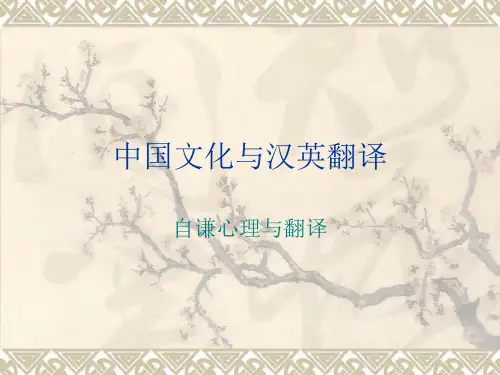
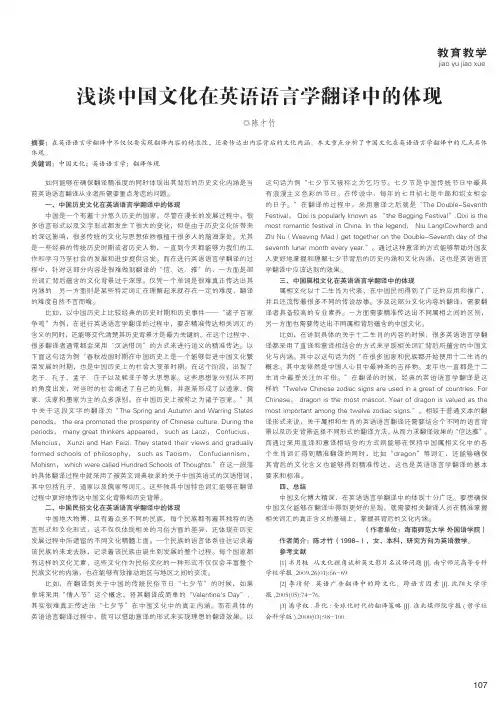
教育教学jiao yu jiao xue107浅谈中国文化在英语语言学翻译中的体现◎陈才竹摘要:在英语语言学翻译中不仅仅要实现翻译内容的精准性,还要传达出内容背后的文化内涵。
本文重点分析了中国文化在英语语言学翻译中的几点具体体现。
关键词:中国文化;英语语言学;翻译体现如何能够在确保翻译精准度的同时体现出其背后的历史文化内涵是当前英语语言翻译从业者所需要重点考虑的问题。
一、中国历史文化在英语语言学翻译中的体现中国是一个有着十分悠久历史的国家,尽管在漫长的发展过程中,很多语言形式以及文字形式都发生了很大的变化,但是由于历史文化所带来的深远影响,很多传统的文化与思想依然根植于很多人的脑海深处。
尤其是一些经典的传统历史时期或者历史人物,一直到今天都能够为我们的工作和学习乃至社会的发展和进步提供启发。
而在进行英语语言学翻译的过程中,针对这部分内容是很难做到翻译的“信、达、雅”的,一方面是部分词汇背后蕴含的文化背景过于深厚,仅凭一个单词是很难真正传达出其内涵的;另一方面则是某些特定词汇在理解起来就存在一定的难度,翻译的难度自然不言而喻。
比如,以中国历史上比较经典的历史时期和历史事件——“诸子百家争鸣”为例,在进行英语语言学翻译的过程中,要在精准传达相关词汇的含义的同时,还能够交代清楚其历史背景才是最为关键的。
在这个过程中,很多翻译者通常都会采用“汉语借词”的方式来进行语义的精准传达。
以下面这句话为例“春秋战国时期在中国历史上是一个能够促进中国文化繁荣发展的时期,也是中国历史上的社会大变革时期。
在这个阶段,出现了老子、孔子、孟子、庄子以及韩非子等大思想家。
这些思想家分别从不同的角度出发,对当时的社会阐述了自己的见解,并逐渐形成了以道家、儒家、法家和墨家为主的众多派别,在中国历史上被称之为诸子百家。
”其中关于这段文字的翻译为“The Spring and Autumn and Warring Statesperiods, the era promoted the prosperity of Chinese culture. During theperiods, many great thinkers appeared, such as Laozi, Confucius,Mencius, Xunzi and Han Feizi. They stated their views and graduallyformed schools of philosophy, such as Taoism, Confuciannism,Mohism, which were called Hundred Schools of Thoughts.”在这一段落的具体翻译过程中就采用了被英文词典收录的关于中国英语式的汉语借词,其中包括孔子、道家以及儒家等词汇。
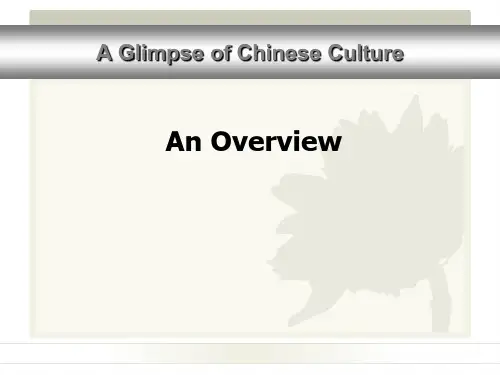
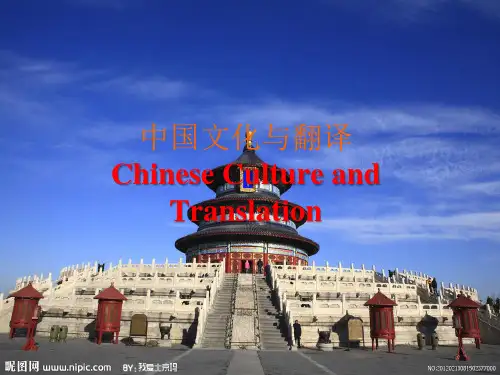
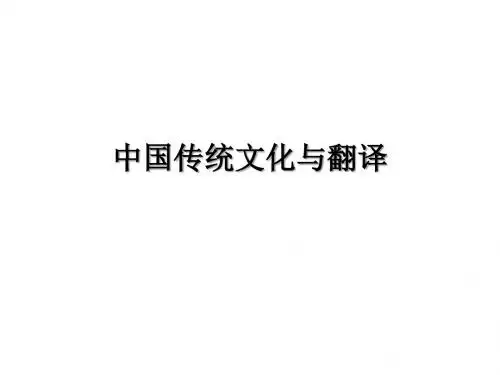

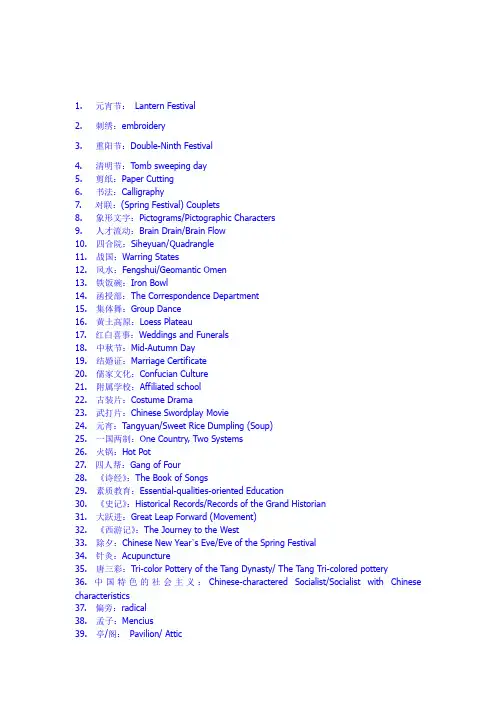
1. 元宵节:Lantern Festival2. 刺绣:embroidery3. 重阳节:Double-Ninth Festival4. 清明节:Tomb sweeping day5. 剪纸:Paper Cutting6. 书法:Calligraphy7. 对联:(Spring Festival) Couplets8. 象形文字:Pictograms/Pictographic Characters9. 人才流动:Brain Drain/Brain Flow10. 四合院:Siheyuan/Quadrangle11. 战国:Warring States12. 风水:Fengshui/Geomantic Omen13. 铁饭碗:Iron Bowl14. 函授部:The Correspondence Department15. 集体舞:Group Dance16. 黄土高原:Loess Plateau17. 红白喜事:Weddings and Funerals18. 中秋节:Mid-Autumn Day19. 结婚证:Marriage Certificate20. 儒家文化:Confucian Culture21. 附属学校:Affiliated school22. 古装片:Costume Drama23. 武打片:Chinese Swordplay Movie24. 元宵:Tangyuan/Sweet Rice Dumpling (Soup)25. 一国两制:One Country, Two Systems26. 火锅:Hot Pot27. 四人帮:Gang of Four28. 《诗经》:The Book of Songs29. 素质教育:Essential-qualities-oriented Education30. 《史记》:Historical Records/Records of the Grand Historian31. 大跃进:Great Leap Forward (Movement)32. 《西游记》:The Journey to the West33. 除夕:Chinese New Year’s Eve/Eve of the Spring Festival34. 针灸:Acupuncture35. 唐三彩:Tri-color Pottery of the Tang Dynasty/ The Tang Tri-colored pottery36. 中国特色的社会主义:Chinese-charactered Socialist/Socialist with Chinese characteristics37. 偏旁:radical38. 孟子:Mencius39. 亭/阁:Pavilion/ Attic40. 大中型国有企业:Large and Medium-sized State-owned Enterprises41. 火药:gunpowder42. 农历:Lunar Calendar43. 印/玺:Seal/Stamp44. 物质精神文明建设:The Construction of Material Civilization and Spiritual Civilization45. 京剧:Beijing Opera/Peking Opera46. 秦腔:Crying of Qin People/Qin Opera47. 太极拳:Tai Chi48. 独生子女证:The Certificate of One-child49. 天坛:Altar of Heaven in Beijing50. 小吃摊:Snack Bar/Snack Stand51. 红双喜:Double Happiness52. 政治辅导员:Political Counselor/School Counselor53. 春卷:Spring Roll(s)54. 莲藕:Lotus Root55. 追星族:Star Struck56. 故宫博物院:The Palace Museum57. 相声:Cross-talk/Comic Dialogue58. 下岗:Lay off/Laid off59. 北京烤鸭:Beijing Roast Duck60. 高等自学考试:Self-taught Examination of Higher Education61. 烟花爆竹:fireworks and firecracker62. 敦煌莫高窟:Mogao Caves63. 电视小品:TV Sketch/TV Skit64. 香港澳门同胞:Compatriots from Hong Kong and Macao65. 文化大革命:Cultural Revolution66. 长江中下游地区:The Mid-low Reaches of Yangtze River67. 门当户对:Perfect Match/Exact Match68. 《水浒》:Water Margin/Outlaws of the Marsh69. 中外合资企业:Joint Ventures70. 文房四宝(笔墨纸砚):"The Four Treasure of the Study" "Brush, Inkstick, Paper, and Inkstone"71.兵马俑:cotta Warriors/ Terracotta Army72.旗袍:cheongsam要了解中国文化,就应该对中国的戏曲文化有所了解。
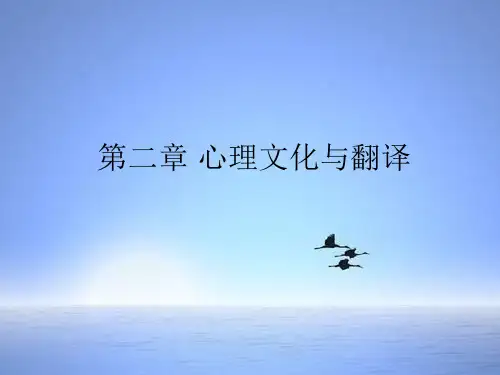
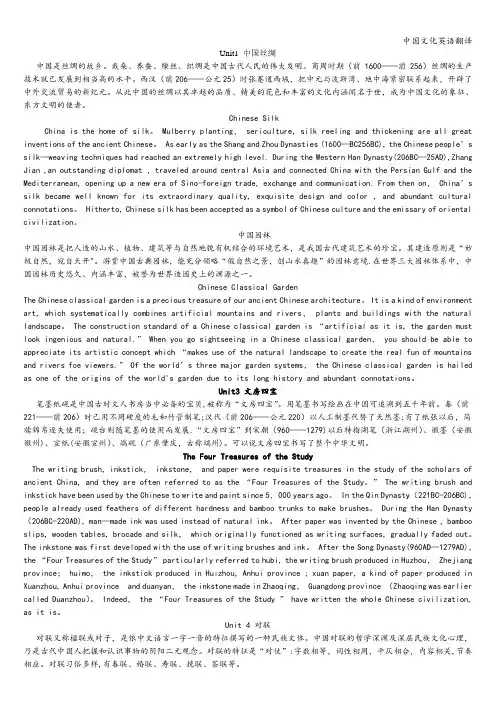
Unit1 中国丝绸中国是丝绸的故乡。
栽桑、养蚕、缫丝、织绸是中国古代人民的伟大发明。
商周时期(前1600——前256)丝绸的生产技术就已发展到相当高的水平。
西汉(前206——公元25)时张蹇通西域,把中元与波斯湾、地中海紧密联系起来,开辟了中外交流贸易的新纪元。
从此中国的丝绸以其卓越的品质、精美的花色和丰富的文化内涵闻名于世,成为中国文化的象征、东方文明的使者。
Chinese SilkChina is the home of silk。
Mulberry planting, sericulture, silk reeling and thickening are all great inventions of the ancient Chinese。
As early as the Shang and Zhou Dynasties (1600—BC256BC), the Chinese people’s silk—weaving techniques had reached an extremely high level. During the Western Han Dynasty(206BC—25AD),Zhang Jian ,an outstanding diplomat ,traveled around central Asia and connected China with the Persian Gulf and the Mediterranean, opening up a new era of Sino-foreign trade, exchange and communication. From then on, China’s silk became well known for its extraordinary quality, exquisite design and color , and abundant cultural connotations。
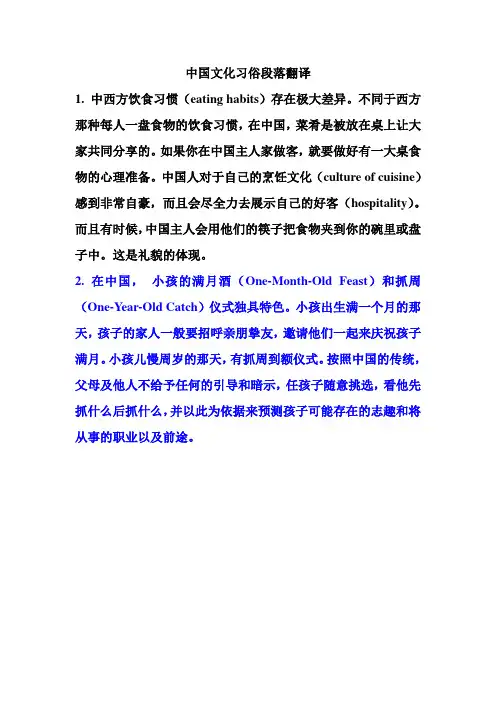
中国文化习俗段落翻译1. 中西方饮食习惯(eating habits)存在极大差异。
不同于西方那种每人一盘食物的饮食习惯,在中国,菜肴是被放在桌上让大家共同分享的。
如果你在中国主人家做客,就要做好有一大桌食物的心理准备。
中国人对于自己的烹饪文化(culture of cuisine)感到非常自豪,而且会尽全力去展示自己的好客(hospitality)。
而且有时候,中国主人会用他们的筷子把食物夹到你的碗里或盘子中。
这是礼貌的体现。
2. 在中国,小孩的满月酒(One-Month-Old Feast)和抓周(One-Year-Old Catch)仪式独具特色。
小孩出生满一个月的那天,孩子的家人一般要招呼亲朋挚友,邀请他们一起来庆祝孩子满月。
小孩儿慢周岁的那天,有抓周到额仪式。
按照中国的传统,父母及他人不给予任何的引导和暗示,任孩子随意挑选,看他先抓什么后抓什么,并以此为依据来预测孩子可能存在的志趣和将从事的职业以及前途。
参考译文1.There are great differences between Chinese and Western eating habits. Unlike the West, where everyone has their own plate of food, in China the dishes are placed on the table and everybody shares. If you are being treated by a Chinese host, be prepared for a table of food. Chinese are very proud of their culture of cuisine and will do their best to show their hospitality. And sometimes the Chinese hosts use their chopsticks to put food in your bowl or plate. This is a sign of politeness.参考译文2: In China, One-Month-Old Feast and One-Year-Old Catch of a baby are of unique Chinese characteristics. On the day when a baby is a month old, the family of the baby will invite their friends and relatives to a ceremony to celebrate the occasion. On the day when a baby is one year old, there is a ceremony of One-Year-Old Catch. According to Chinese traditional custom, nobody will give any instruction or clue to the baby so that it is left free to choose by itself. Watching the baby catch the articles it likes, the family can then make predictions about its potential interest, future career and development.春节贴年画(pasting New Year Print s)的风俗源自于往房子外面的门上贴门神(Door Gods)的传统,随着木质雕刻品(board carvings)的出现,年画包含了更广泛地主题,最出名的就是门神,三大神——福神、薪神、和兽神(three Gods of Blessings, Salary and Longevity),寓意着庄稼丰收、家畜兴旺和庆祝春节。
一、对龙图腾他的崇拜在中国大约已绵延了八千多年。
中国龙是古人将鱼、蛇、马、牛等动物与云雾、雷电等自然天象集合而成的一种神物。
中国龙的形成与中华民族的多元融合过程同步。
在中国人的心目中,龙具有振奋腾飞、开拓变化的寓意和团结凝聚的精神。
Chinese Dragon Dragon totem worship in China has been around for the last 8,000 years. The ancients in China considered the dragon (or loong) a fetish that combines animals including the fish, snake, horse and ox with cloud, thunder, lightning and other natural celestial phenomena. The Chinese dragon was formed in accordance with the multicultural fusion process of the Chinese nation. To the Chinese, the dragon signifies innovation and cohesion.二、秧歌舞是中国汉族的一种民间传统舞蹈,通常在北方省份表演。
秧歌舞者通常穿上明亮多彩的表演服装,他们的表演动作有力迅速。
在农历春节、元宵节等节日期间,人们一旦听到锣鼓声,不管外面天气有多冷,他们都会蜂拥到街上看秧歌舞表演。
近年来,中国东北某些城市的老年人自发组织了了秧歌队,队员常年通过跳秧歌舞来保持健康,同事他们也乐在其中。
Yangko is one of tradition folk dance of Han in China.It is usually performed in northern provinces. The dancers usually wear colorful and light costumes, and the performance is powerful and rapid. During some festivals such as Spring Festival, Lantein Festival, if people hear the sound of drum and gong, no matter how cold the weather is , they will come to street and appreciate the Yangko. Recent years, the old people in city of east-northern of China organized the team of Yangko by themselves, the teamers keep their health by dancing Yangko the whole year.三、长城是人类创造的世界奇迹之一。
1. 中国结每逢春节,无论你走在中国的城市商业街,还是世界各地的唐人街,那些琳琅满目、形态各异、“中国结”全称。
它有悠久的历史,是渗透中华民族特有的文化底蕴的一种手工编织工艺品。
Chinese KnotDuring Spring Festival, a great variety of beautiful and graceful Chinese knots on the commercial streets of Chinese cities or in the Chinatown throughout the world bring a strong Chinese flavor. The full name of a “Chinese knot”is a “Traditional Chinese decorative Knot”. Having a long history, the knot handicraft is infiltrated with acultural meaning unique for Chinese people. Today, the Chinese knot has become a Chinese symbol with a flavor of oriental culture.2. 中国的传统节日中国的传统节日颇为不少,如春节、元宵节、端午节、中秋节、重阳节等等,还有许多少数民族的民俗节日。
随着时间的推移,这些节日逐渐成为中华民族的传统节日。
近年来,随着民族文化的复兴和发展,人们越发珍视传统节日。
对于普通百姓来说,这些传统节日就是与家人团圆的宝贵时间。
许多传统的节日食品,如春节的年糕、中秋的月饼,也成为了人们传递问候和祝愿的最佳选择。
(171)Traditional Chinese FestivalsChina has many traditional festivals, such as Spring Festival, Lantern Festival, Mid-autumn Day, Dragon Boat Festival, the Double Ninth Festival, etc. along with some particular festivals celebrated by ethnicminorities. As time passed, these gradually developed into traditional festivals for the Chinese nation. In recent years, with therehabilitation and development of traditional culture,people began to attach more value to these native festivals. For ordinary people, these traditional festivals are precious time for reunion with their family members. Many traditional festival foods, such as Niangao for Spring Festival, mooncakes for Mid-autumn Day, have become best choices for people to send their greetings and wishes to their relatives and friends.3. 私家车就在20多年前,走在中国的城市街区,你会发现骑自行车上班的车队川流不息,所以外国人形象地称中国为“自行车的海洋”或“自行车的王国”。
中国文化常识Chinese Cultural Common Sense概述中华民族是一个古老的民族,也是一个有深厚文化底蕴的民族。
中国的传统艺术门类繁多、雅俗共赏,从悠扬动人的民间音乐到细腻缠绵的地方戏曲,从疏洁淡雅的水墨画到刚柔并济的书法,无不闪烁着智慧之光,令人赞叹不已。
SummarizeThe Chinese nation is an ancient nation with profound culture deposits. The Chinese traditional culture owns a great varieties; it suits both refined and popular tastes, from the melodious and touching folk music to the exquisite and lingering local operas, from the simple and elegant wash painting to the calligraphies with both hardness and softness, all of them are sparkling with wisdom, which makes people deeply admired.舞狮舞狮大约起源于南北朝时期,到了唐朝,狮子舞已发展为上百人集体表演的大型歌舞。
舞狮在中国是一项传统体育项目,也是一种传统文化艺术,从北方到南方,从城市到乡村,逢年过节及庆典盛事,都可以看到欢快的舞狮。
民间认为舞狮可以很好地把百姓的欢喜心情表达出来,也最能烘托热闹气氛。
舞狮尤以广东地区一带最为盛行。
用来舞动的狮子外形威武,动作刚劲,神态多变,广东人称它为“醒狮”。
中国百姓对狮子有图腾般的崇敬感,狮子在民间有很多传说,其位置仅次于龙,因此舞狮也就带有了不少神秘色彩。
人们相信狮子是吉祥瑞兽,而舞狮能够带来好运,所以每逢节日和喜庆活动,都会舞狮助兴,祈求吉利和如意。
“中国文化与翻译”课程教学大纲一、课程基本信息开课单位:翻译学院翻译系课程名称:中国文化与翻译课程编号:224107英文名称:Chinese Culture and Translation课程类型:专业拓展课总学时:36 理论学时:36 实验学时:学分:2开设专业:翻译专业;商务英语专业先修课程:无二、课程任务目标(一)课程任务本课程是面向英语语言文学专业(翻译方向)和翻译专业开设的一门专业方向限选课,属于文化通识类课程,一般在三年级或四年级开设。
本课程的任务是使学生既能把握中国文化的全貌及其内涵,又能学会用英文表达、介绍中国文化,为将来用英文传播中国文化打下初步的基础。
(二)课程目标在学完本课程之后,学生能够:1.了解中国文化的英文表达方式;2.用英语介绍中国文化的主要内容;3.比较中英文化的异同;4.了解文化与翻译的关系;5.为中国文化走出去的国家战略服务。
三、教学内容和要求第一章中国文化概述1.弄清文化的基本含义;2.了解中国的国庆节、国旗、国徽、国歌、首都以及地理概貌、历史概况、行政区划、人口、少数民族分布、政治体制以及经济发展与改革等基本信息;3.了解中国人口的优势、不足及其对策;4.了解中国经济发展与环保之间的关系;第二章中国的哲学与宗教1.了解中国哲学的演变和基本特点;2.了解中国宗教的演变和基本特点;3.比较中西哲学的异同;4.比较中西宗教的异同;5.了解宗教对中国语言、文化和思维的影响。
第三章中国文学1.了解中国古典文学、现代文学、当代文学三个时期重要作家的作品及其文学思想;2.了解中国四大名著的内容及其英译;3.了解莫言的作品及其英译问题。
第四章中国艺术1.了解中国的书画、传统戏曲、民间表演艺术以及传统乐器等知识;2.掌握主要中国艺术形式的英译;3.掌握以地名命名的文房四宝和戏曲名称英译的统一性问题。
第五章中国教育1.了解中国传统教育的历史演变过程;2.了解现代教育的特点;3.了解对外交流与合作的状况;4.掌握中国教育关键词的翻译问题。
中国传统文化中英文翻译1.元宵节:Lantern Festival2.刺绣:embroidery3.重阳节:Double-Ninth Festival4.清明节:Tomb sweeping day5.剪纸:Paper Cutting6.书法:Calligraphy7.对联:(Spring Festival) Couplets8.象形文字:Pictograms/Pictographic Characters9.人才流动:Brain Drain/Brain Flow10.四合院:Siheyuan/Quadrangle11.战国:Warring States12.风水:Fengshui/Geomantic Omen13.铁饭碗:Iron Bowl14.函授部:The Correspondence Department15.集体舞:Group Dance16.黄土高原:Loess Plateau17.红白喜事:Weddings and Funerals18.中秋节:Mid-Autumn Day19.结婚证:Marriage Certificate20.儒家文化:Confucian Culture21.附属学校:Affiliated school22.古装片:Costume Drama23.武打片:Chinese Swordplay Movie24.元宵:Tangyuan/Sweet Rice Dumpling (Soup)25.一国两制:One Country, Two Systems26.火锅:Hot Pot27.四人帮:Gang of Four28.《诗经》:The Book of Songs29.素质教育:Essential-qualities-oriented Education30.《史记》:Historical Records/Records of the Grand Historian31.大跃进:Great Leap Forward (Movement)32.《西游记》:The Journey to the West33.除夕:Chinese New Year’s Eve/Eve of the Spring F estival34.针灸:Acupuncture35.唐三彩:Tri-color Pottery of the Tang Dynasty/ The Tang Tri-colored pottery36.中国特色的社会主义:Chinese-charactered Socialist/Socialist with Chinese characteristics37.偏旁:radical38.孟子:Mencius39.亭/阁:Pavilion/ Attic40.大中型国有企业:Large and Medium-sized State-owned Enterprises41.火药:gunpowder42.农历:Lunar Calendar43.印/玺:Seal/Stamp44.物质精神文明建设:The Construction of Material Civilization and Spiritual Civilization45.京剧:Beijing Opera/Peking Opera46.秦腔:Crying of Qin People/Qin Opera47.太极拳:Tai Chi48.独生子女证:The Certificate of One-child49.天坛:Altar of Heaven in Beijing50.小吃摊:Snack Bar/Snack Stand51.红双喜:Double Happiness52.政治辅导员:Political Counselor/School Counselor53.春卷:Spring Roll(s)54.莲藕:Lotus Root55.追星族:Star Struck56.故宫博物院:The Palace Museum57.相声:Cross-talk/Comic Dialogue58.下岗:Lay off/Laid off59.北京烤鸭:Beijing Roast Duck60.高等自学考试:Self-taught Examination of Higher Education61.烟花爆竹:fireworks and firecracker62.敦煌莫高窟:Mogao Caves63.电视小品:TV Sketch/TV Skit64.香港澳门同胞:Compatriots from Hong Kong and Macao65.文化大革命:Cultural Revolution66.长江中下游地区:The Mid-low Reaches of Yangtze River67.门当户对:Perfect Match/Exact Match68.《水浒》:Water Margin/Outlaws of the Marsh69.中外合资企业:Joint Ventures70.文房四宝(笔墨纸砚):"The Four Treasure of the Study" "Brush, Inkstick, Paper, and Inkstone"71.兵马俑:cotta Warriors/ Terracotta Army。